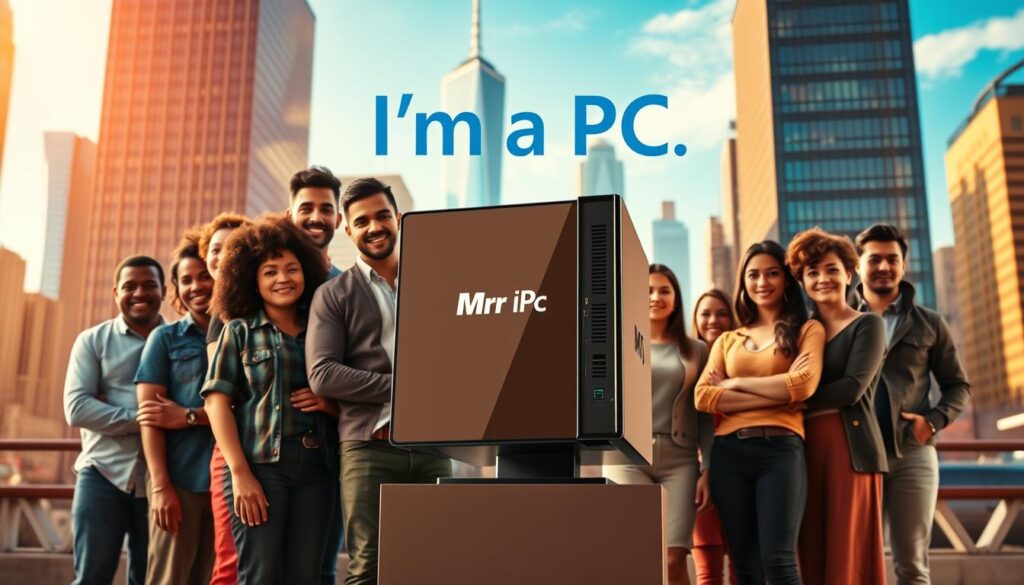
In 2008, Microsoft launched its groundbreaking “I’m a PC” campaign with a staggering $300 million budget. This bold move was a direct response to Apple’s “Get a Mac” campaign, which had portrayed PC users in a stereotypical light. Microsoft’s strategy was clear: to humanize PC users and showcase their diversity, breaking free from the molds cast by their competitors.
The campaign, created by Crispin Porter + Bogusky (CPB), featured a mix of celebrities and everyday individuals. One notable example was Microsoft employee Sean Siler, styled to resemble John Hodgman, who was famous for his role in Apple’s ads. This approach not only added a layer of familiarity but also highlighted the real people behind the PCs, emphasizing that users were far from the dull, corporate stereotypes often portrayed.
By focusing on real stories and diverse characters, Microsoft aimed to redefine what it meant to be a PC user. This campaign was more than just a series of ads; it was a movement to instill pride and a sense of community among PC enthusiasts. It underscored that PCs were not just tools for business but a window into a world of creativity, productivity, and connectivity for people from all walks of life.
Through this campaign, Microsoft successfully positioned itself as a brand that understood and celebrated the uniqueness of its users. By doing so, it carved out a distinct identity in the competitive tech landscape, proving that being a PC user was something to be proud of.
Campaign Background and Strategic Context
In 2008, the tech world witnessed a pivotal moment when a major company launched a campaign to redefine its brand identity. This initiative was a direct response to a competitor’s successful advertising strategy that had shaped public perception.
Origins of the “I’m a PC” Initiative
The campaign was developed by Crispin Porter + Bogusky, aiming to challenge stereotypes. By featuring both everyday users and celebrities like Eva Longoria, it showcased diversity and real-life experiences, countering the notion that users were bland.
Challenging Stereotypes and Apple’s Dominance
Apple’s “Get a Mac” ads had portrayed users in a stereotypical light, prompting a response. The campaign strategically highlighted relatable characters, emphasizing that users were diverse and creative, not just corporate. This approach was a deliberate shift to humanize the brand.
| Feature | “I’m a PC” | “Get a Mac” |
|---|---|---|
| Target Audience | Diverse users | Young urban |
| Messaging | Inclusivity, creativity | Exclusivity |
| Strategy | Real stories | Stereotypes |
This campaign was more than ads; it was a movement to instill pride and community among users, proving that being part of this group was something to be proud of.
Microsoft I’m a PC Campaign Analysis
The “I’m a PC” campaign marked a strategic shift in how the brand presented itself to the world. By focusing on real stories and diverse characters, the campaign aimed to redefine what it meant to be a PC user. This approach was a direct response to the stereotypes portrayed in Apple’s “Get a Mac” ads, which often depicted PC users in a less favorable light.
Core Messaging and Campaign Goals
The core of the campaign was built around inclusivity and authenticity. By featuring both everyday users and celebrities, the ads showcased the diversity of PC users. This strategy was designed to counter the negative stereotypes perpetuated by competitors, emphasizing that PC users were not just corporate but also creative and diverse.
Visual Style and Narrative Approach
The visual style of the campaign blended authenticity with a cinematic quality. High-production-value ads were mixed with real-user testimonials, creating a sense of relatability. This approach highlighted the real people behind the PCs, making the campaign feel more like a movement than just a series of ads.
Comparison with Apple’s “Get a Mac” Advertisements
While Apple’s ads focused on exclusivity and stereotypes, Microsoft’s campaign took an opposite approach. The “I’m a PC” ads emphasized inclusivity and creativity, showcasing a wide range of users. This contrast in tone and execution helped Microsoft carve out a distinct identity in the tech landscape.
Bill Gates himself noted the importance of this campaign in repositioning the brand. By celebrating the uniqueness of its users, Microsoft aimed to instill pride and a sense of community among PC enthusiasts. This strategy not only countered Apple’s portrayal but also highlighted the versatility of PCs as a tool for both business and creativity.

| Feature | Microsoft’s “I’m a PC” | Apple’s “Get a Mac” |
|---|---|---|
| Target Audience | Diverse users | Young urban |
| Messaging | Inclusivity, creativity | Exclusivity |
| Strategy | Real stories | Stereotypes |
Learn more about how this campaign fits into the broader transparent tech revolution and the innovations shaping the industry.
Public and Media Reactions
The “I’m a PC” campaign sparked a wave of reactions from both the public and media. Bill Gates publicly criticized Apple’s ads for exaggerating the difficulties of using Windows, emphasizing that the portrayal was far from reality. He highlighted Microsoft’s approach to inclusivity, stating that the campaign aimed to show the diverse and creative side of PC users.
Bill Gates’ Perspective and Critique of Apple Ads
Gates pointed out that Apple’s ads often relied on stereotypes, which he believed were misleading. He explained that Microsoft’s campaign was designed to counter these stereotypes by featuring real stories of PC users, from everyday people to celebrities like Eva Longoria. This approach was meant to humanize the brand and showcase the versatility of PCs beyond just business use.
Community and Media Feedback
The campaign received mixed reactions. While some praised its inclusive message, others felt it lacked the edge of Apple’s ads. Media outlets noted the strategic shift in Microsoft’s branding, with many highlighting the campaign’s ability to resonate with a broader audience. The discussion around the campaign also sparked debates on what it means to be a PC user, with some arguing that the “everyperson” approach risked being seen as bland.

Learn more about how this campaign fits into the broader transparent tech revolution and the innovations shaping the industry.
Conclusion
In the ever-evolving tech landscape, the “I’m a PC” campaign stands as a testament to how strategic advertising can reshape brand perception. By focusing on real stories and diverse characters, the initiative successfully humanized PC users, offering a stark contrast to Apple’s “Get a Mac” ads which often relied on stereotypes.
The campaign’s approach was both inclusive and authentic, featuring everyday individuals alongside celebrities. This strategy not only countered Apple’s narrative but also highlighted the versatility of PCs, positioning them as tools for both creativity and productivity. The high-production-value ads, combined with real-user testimonials, created a sense of relatability that resonated deeply with audiences.
Looking ahead, such campaigns underscore the importance of emotional connection in marketing. By emphasizing user experience and diversity, brands can create meaningful engagements that go beyond mere product promotion. As the tech industry continues to evolve, the lessons from this campaign will undoubtedly influence future strategies, shaping how companies connect with their audiences in a more personal and impactful way.
Learn more about how this campaign fits into the broader transparent tech revolution and the innovations shaping the industry.

 Microsoft’s “I’m a PC” Campaign: Humanizing PC Users Against Apple
Microsoft’s “I’m a PC” Campaign: Humanizing PC Users Against Apple
0 Comment